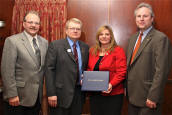Funding is a hurdle for crowded Interstate 81
Most public officials and users agree:
Interstate 81 is overcrowded and
underfunded. But in contrast to the gung-ho
early days of the interstate highway system,
public and political commitment to a
billion-dollar expansion in multiple states
has yet to coalesce.
More than a decade ago, state officials
began kicking around the idea of widening
the I-81 corridor in southcentral
Pennsylvania, due to the growing volume of
vehicles — most notably trucks — using the
major north-south transportation artery to
travel the eastern seaboard. The corridor is
within two days’ delivery time of about half
of all U.S. markets.
Following years of lobbying from elected
officials, the state Department of
Transportation committed in 2001 to a
two-year study to start the process of
widening the highway to six lanes on a
77-mile stretch, beginning at the Maryland
state line to Route 581 in Cumberland County
and from I-83 in Dauphin County to the I-78
split in Lebanon County. Widening talks were
also going on in neighboring I-81 states,
including Maryland, Virginia and West
Virginia.
The $2 million study done by DMJM Harris
wrapped up in 2004.
The price tag to widen the corridor was
estimated at $1 billion — a figure deemed
too high by state officials, despite daily
truck traffic between 28 and 39 percent on
an interstate system designed to handle an
average of 15 percent trucks.
A June report by the American Association of
State Highway and Transportation Officials
updated the estimate to $1.8 billion.
PennDOT District 8 spokesman Greg Penny said
in 2004 that it was “very unlikely” the
agency could appropriate funding to widen
the entire corridor. Nearly seven years
later, funding continues to be a major
hurdle for the state.
“HATS can’t find the money,” Penny said
recently, referring to the Harrisburg Area
Transportation Study, the regional planning
organization for Cumberland, Dauphin and
Perry counties that approves and programs
every public transportation project for
federal, state and local funding. With heavy
development pressure from warehouse and
distribution centers along the corridor, the
I-81 widening study pegged 2002 traffic
volumes between 40,000 and 80,000 vehicles
per day in both directions.
The average daily traffic count was 43,700,
with trucks making up about 35 percent of
that volume, the study noted, not including
the six-lane section between Exit 59, where
I-81 meets Route 581, and Exit 70, where
I-81 meets I-83. A 2030 projection in that
study shows average annual daily traffic
volumes ranging between 100,000 and 150,000
vehicles.
“We could be the bottleneck,” said Kirk
Stoner, planning director for Cumberland
County. “Who knows? The estimates are
computer projections.”
Other I-81 states, including Maryland and
West Virginia, also have been studying ways
to improve the highway in their respective
states.
In response to public input and a request
early in 2006 from the General Assembly, the
Commonwealth Transportation Board in October
2006 directed the Virginia Department of
Transportation to “implement safety and
operational improvements to existing I-81”
and “improve I-81 by constructing not more
than one or two general purpose lanes in
each direction, only where needed, to meet
future traffic demand.”
“Currently, there is no funding or plans to
widen the entire I-81 corridor in Virginia,”
Heidi Underwood, a VDOT spokeswoman, said
this fall. “However, safety and operational
improvements are under way, such as the
construction of truck climbing lanes in
Montgomery and Rockbridge counties.
About 10 years ago, VDOT’s six-year
improvement plan did include funds to begin
design work on widening sections of I-81,
specifically 16 miles in the Roanoke Valley,
a truck-climbing lane in Rockbridge County
and sections in the Winchester and
Harrisonburg areas, she noted.
“These design projects had been identified
as priorities by the CTB based on the I-81
feasibility study completed by VDOT in the
late 1990s,” she said. “Design was funded
and got under way, but it was suspended when
VDOT began a corridor-improvement study in
2004.”
In Maryland, there is a project in the
planning phase to reconstruct I-81, which
spans just 12.08 miles in the state.
About 76,000 vehicles — 35 percent of those
trucks — travel I-81 in Maryland every day,
according to Charlie Gischlar, a spokesman
for the State Highway Administration, which
maintains I-81. Projections through 2030
have traffic increasing to 100,000 vehicles
per day, he added.
The project is estimated to cost $743
million. Planning has been completed,
Gischlar noted, but there is no funding for
design.
“It is a ton of money that right now is
going to be very difficult to achieve,” he
said. “With the financial climate, this
wouldn’t be funded next year. That doesn’t
mean one day we might not break off a
section. We may do it as breakout projects,
if it does move forward.”
U.S. Rep. Todd Platts, R-19, expects
something similar could happen in
Pennsylvania, if a widening project ever
tops the list of priorities again for the
state.
“That project will eat up all of the highway
funds for years to come for the entire
region,” he said. “We’re going to have to do
it in a staged approach, and that’s still
going to be dramatic in the cost.”
For the I-81 widening project to work in
Pennsylvania, it needs to be prioritized at
the state level, Platts said, as opposed to
the local Metropolitan Planning
Organization.
“It’s a project that would spike the MPO
budget so dramatically. It’s not financially
doable for the local MPO,” he said. If all
local and county officials push for the
project and it becomes a state priority,
Platts said, he would advocate for federal
funding.
The funding crisis we’re in is “very real,”
Stoner said. “We know what the needs are.
The funding is just not there.”
A recent state study estimated it would take
about $3.5 billion annually to fully fund
the state’s transportation needs. In August,
the Rendell administration proposed $1
billion annually in new funding — by taxing
oil company gross profits and increasing
motorist fees — to address the crisis. About
70 percent of the new money would go to
highways and bridges, while the rest would
be for mass transit, Transportation
Secretary Allen Biehler said.
The administration pegged the number of
structurally deficient, state-owned bridges
at 5,646, the most in the country. At the
time, there were also more than 7,000 miles
of roadway in poor condition.
A transportation funding study put out by
the Pennsylvania State Transportation
Advisory Committee in May said that new
sources of revenue need to be identified,
and existing sources need to be re-examined
to provide funding that “meets the enormous
investment need.”
State and local officials agree. In the
report, several recommendations were made,
including a more direct user-pay system such
as a vehicle-miles-traveled fee. VMT fees
are flexible and also allow for peak-hour
pricing and dedicated lanes in highly
congested areas.
Tolling options on major highways was
another recommendation, along with the
expansion of public-private partnerships,
strategic borrowing and local option taxes.
“We need to probably keep fuel taxes, but
move into some other funding source,” Stoner
said.
There seems to be no question in the mind of
current and past officials, including
retired 9th District Congressman Bud
Shuster, that the interstate system has been
vital to the continued development of the
region.
“The evidence is overwhelming that where you
put an interstate system several things
happen,” said Shuster, who chaired the U.S.
House Committee on Transportation and
Infrastructure from 1995 to 2001. It
bolsters the transportation network for the
traveling public and helps with safety, he
said.
The interstate system is also a “magnet for
business development,” Shuster said.
Shuster said local and regional leaders have
to make improvement projects such as
widening I-81 to six lanes a priority.
Causer Appointed to House Appropriations Committee
Rep. Martin Causer (R-Turtlepoint) today was
appointed to the state House Appropriations
Committee, giving the fifth-term lawmaker
greater standing in the development of the
annual state budget.
“My number one priority this year is for the
state House to adopt an on-time, fiscally
responsible state budget, and I believe my
appointment to the Appropriations Committee
will help us reach that goal,” Causer said.
“Many of the people I represent have told me
enough is enough when it comes to government
spending, and I could not agree more. I will
make sure their voices are heard loud and
clear in this year’s budget negotiations.”
As a member of the committee, Causer will
participate in a series of in-depth hearings
with officials from every major state agency
and department to determine their budgetary
needs. He also will play a role in
monitoring ongoing expenditures to ensure
departments are operating within the
confines of the enacted state budget.
Additionally, the Appropriations Committee
is responsible for reviewing all legislation
to analyze the fiscal impact it may have on
the Commonwealth.
“This year’s budget is sure to be a
challenge with an estimated revenue
shortfall of at least $4 billion,” Causer
said. “We have a lot of work to do to make
up for the overspending of the Rendell
administration.”
In addition to his new role on the
Appropriations Committee, Causer will also
serve on the Health Committee for the first
time in his tenure with the state House.
“I am very happy to have the opportunity to
serve on this committee and advocate for our
rural hospitals and health care system,”
Causer said. “It is vital for our citizens
to have access to affordable, quality health
care without having to travel to Pittsburgh,
Erie or New York to get it.”
Causer also will continue his service on the
House Environmental Resources and Energy
Committee, and the Veterans Affairs and
Emergency Preparedness Committee.
His goals as a member of the Environmental
Resources and Energy Committee include
expanding the state’s alternative energy
opportunities as well as facilitating the
ongoing development of the Marcellus Shale
natural gas drilling industry. Causer said
he wants to ensure the region benefits from
the economic opportunities presented by the
Marcellus, but he also recognizes the
importance of protecting the state’s water
supply.
The lawmaker is a long-time member of the
House Veterans Affairs and Emergency
Preparedness Committee, to which he brings
his past experience as an EMS volunteer. His
goals on that committee are to continue
providing veterans with the support services
they need and deserve, and to ensure the
public safety of the Commonwealth’s
citizens.
This session, Causer also will continue his
service as chairman of the Legislative
Timber Caucus and vice chairman of the
Firefighter and Emergency Services Caucus.
PA Woman Pleads Guilty In FBI Agent Shooting
PITTSBURGH—A Pittsburgh-area woman who shot a federal agent to death during an early morning raid on her home pleaded guilty Tuesday but said federal agents share the blame for the deadly confrontation.
Christina Korbe, 42, was sentenced to 15 years and 10 months in prison in the 2008 shooting death of Special Agent Samuel Hicks after pleading guilty to voluntary manslaughter and weapons charges.
She apologized to Hicks' wife and family but affixed some of the blame for his death on law enforcement agencies that descended on her home to arrest her husband on drug charges.
"The element of surprise is not worth someone's life," Korbe said.
Korbe repeatedly claimed she fired at Hicks only because she believed the officers who raided her Indiana Township home on Nov. 19, 2008, were unknown intruders. Hicks, 33, of Richland Township, was killed by one shot that struck him just above his bulletproof vest. He left behind a wife and toddler son.
Prosecutors insisted that Hicks and other law officers loudly and clearly identified themselves before using a battering ram to bust through the Korbes' door.
Charlotte Carrabotta, the slain agent's mother, disputed Korbe's claim that she fired to protect her family, including her two children.
"Christina Korbe was not protecting her children," Carrabotta said. "Samuel was protecting her children."
Investigators had also pointed toward the actions taken by Korbe's husband during the raid as proof that agents had clearly identified themselves. The morning Hicks died, Robert Korbe immediately ran downstairs to dispose of cocaine and took other evasive actions that prosecutors contend prove he knew Hicks and the others were law enforcement officers.
Despite the government's arguments that Korbe purposely targeted Hicks, the plea leaves open the possibility that she fired the gun intentionally but didn't necessarily know what was going on. A component of voluntary manslaughter is an emotional state fueled by anger, fear, terror or rage.
Robert Korbe pleaded guilty last year to the cocaine trafficking charges that brought Hicks and the other officers to his home that morning. He is serving 25 years in prison -- nine more than his wife faces.
Pennsylvania Game Commission Prepares For Special Snow Goose Season
HARRISBURG, PA -- Pennsylvania
Game Commission officials are set to offer
hunters the opportunity to participate in a
snow goose conservation hunt designed to
help stem the growth of continental snow
goose populations. Hunters must obtain
a free snow goose conservation hunt permit
and report cards from the agency to
participate in the season, which will be
held from Feb. 21 through April 16.
The daily limit is 25, with no possession
limit.
To do so, hunters can access the "Snow Goose
Conservation Hunt" page by clicking on the
appropriate icon in the center of the
agency's website (www.pgc.state.pa.us)
and then following the instructions.
By completing the application online,
hunters will be able to print off the permit
and report cards and will not have to wait
for the package to be mailed.
For those individuals with no online access,
permits and the required report cards can be
obtained by calling the Game Commission at
the Harrisburg headquarters (717-787-4250)
and asking for the Bureau of Wildlife
Management. However, this process will
require mailing the permit and report cards
to the applicant, so allow a minimum of one
week for processing and mail delivery to
obtain a permit.
"Snow goose populations have reached levels
that are causing extensive and possibly
irreversible damage to their, as well as
other nesting birds', arctic and sub-arctic
breeding grounds," pointed out Kevin Jacobs,
Game Commission waterfowl biologist.
"For some populations of snow geese their
nesting habitats can no longer support these
large numbers. What's more, these
geese are beginning to impact fragile
coastal marsh habitats and crops in
Mid-Atlantic States and Quebec.
"It's likely that North America has never
had as many snow geese as it does now.
The current population of greater snow geese
that inhabits the Atlantic Flyway is
estimated at more than one million birds,
more than double the management goal of
500,000. They have become a huge and
unexpected problem for themselves and other
wildlife that shares the wintering and
breeding grounds these waterfowl occupy."
The quickest and probably most effective way
for wildlife managers to respond to the
problem is to allow additional hunting days
– and new hunting methods – to reduce and
stabilize snow goose populations. Therefore,
as part of this Snow Goose Conservation
Hunt, electronic calls are legal, and legal
shooting hours are from one-half hour before
sunrise until one-half hour after sunset.
Currently, all waterfowl shooting hours
close at sundown, except for the September
Canada goose season, and electronic calls
are not legal for other waterfowl seasons.
"Currently, the regular snow goose season
opened on Nov. 6 and runs through Feb. 19,
with a daily limit of 25 birds," Jacobs
said. "The additional hunting days
offered after Feb. 20 will provide hunters
additional opportunity to harvest snow
geese."
Participating states are required by the
U.S. Fish and Wildlife Service to monitor
and assess hunting activity and harvest.
That is why the Game Commission has created
the free Snow Goose Conservation Hunt
Permit.
"Along with this new permit, hunters must
possess a general hunting license, migratory
game bird license and a federal duck stamp
(for those 16 or older)," Jacobs said.
"The permit holder will be required to
maintain records specifying hunting activity
and daily harvest. All permit holders
must submit a report, even if they did not
hunt or harvest any birds, to the Game
Commission no later than May 17.
Failure to report by May 17 may result in
loss of eligibility to participate in next
year's snow goose conservation hunt."
CCMH's Laboratory And Pathology Services Earn Re-accreditation By The C.A.P.
Charles Cole Memorial
Hospital’s laboratory and pathology services
recently earned re-accredited by the College
of American Pathologists.
According to CAP, accreditation “improves
patient safety by advancing the quality of
pathology and laboratory services through
education, standard setting, and ensuring
laboratories meet or exceed regulatory
requirements. Upon successful completion of
the inspection process, the laboratory is
awarded CAP accreditation and becomes part
of an exclusive group of more than 6,000
laboratories worldwide that have met the
highest standards of excellence.”
“This accreditation demonstrates our high
standards and commitment by providing the
best services to our patients,” said
laboratory director George Locke. “I’m
grateful to our dedicated staff for helping
to reach this important achievement.”
The College of American Pathologists is a
medical society that serves more than 17,000
physician members and the laboratory
community throughout the world. It is
the world's largest association composed
exclusively of pathologists and is widely
recognized as the leader in laboratory
quality assurance. The CAP is an
advocate for high quality and cost-effective
patient care. More information about
Cap can be found at
www.cap.org.











